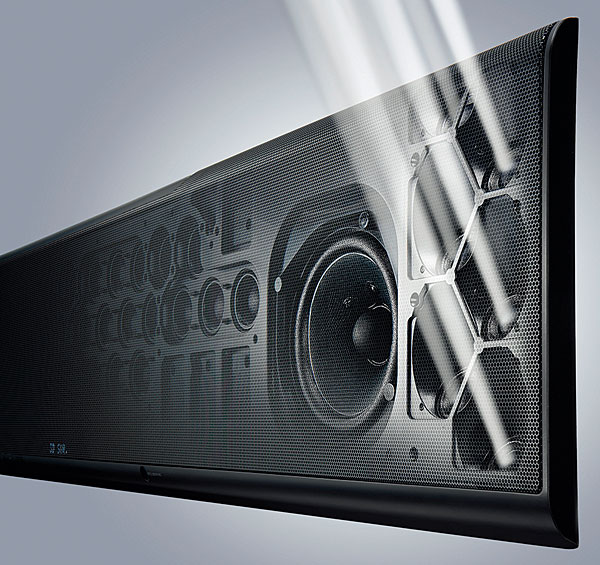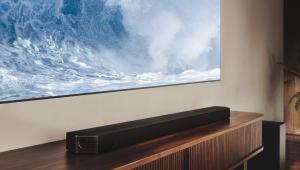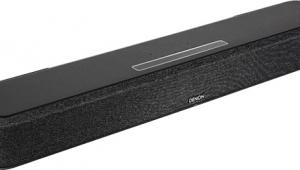Yamaha YSP-5600 Soundbar Review Page 2
The real surprise, though, came out of left field—well, the left rear corner of the room, anyway—during the scene in which Eilis walks away from her mother in the kitchen and heads outside to meet Nancy. As the camera follows Eilis out, I could clearly hear the front door closing behind me. With just about any simulated-surround soundbar I’ve listened to, the sound of the closing door would have been even with my ear or, in the best of cases, slightly behind it. It’s not unusual to hear the unwanted side effects of the phase manipulations required to create a simulated surround field. Although Yamaha does jigger a bit with the phase of each sound beam, it’s done to correct the acoustics associated with bouncing sound beams off walls. With this soundbar, I never heard any of the artifacts that are so common with simulated surround systems.
 Height There, How You Doin’?
Height There, How You Doin’?
I was thoroughly impressed with the Surround setting and never felt like I was anything was missing—at least until I tried the 3D Surround setting on the same scenes. The Brooklyn disc doesn’t have a Dolby Atmos soundtrack, but the YSP-5600’s upmix processing in 3D Surround added noticeable height and depth to the front soundstage. I’m not saying it created an Atmos-
equivalent sensation of a fully formed three-dimensional space. Instead, it added height above and an extension through the front wall, so that a scene involving the bustling crowds and hectic traffic of a Brooklyn street crossing became much more layered and engaging. Even though I’d found the Surround setting so very impressive, going back to it after experiencing 3D Surround made it sound flat and two-dimensional by comparison. In other words, I’d suggest using 3D Surround for everything. It’s that much of an enhancement.
In a sense, listening to a non- Atmos movie with the YSP-5600’s 3D Surround setting made moving on to a disc with Atmos a bit of a letdown. After all, the new soundbar’s claim to fame is being the world’s first soundbar with Atmos, but I’d already been blown away by the Yamaha’s upmixed height channels with Brooklyn.
But the YSP-5600’s performance with an actual Dolby Atmos soundtrack was hardly mediocre or unimpressive. In 2014’s Teenage Mutant Ninja Turtles, for example, when the ceiling of the air tunnel collapses on Donatello, the debris definitely sounded like it fell from the ceiling in the front half of my room. If you’re evaluating a speaker system rather than simply watching the movie, this is a scene where you’ll notice that the Yamaha is Atmos-enabled for the front height channels only. Had I been listening on a system that included rear height channels, it’s likely that the entire ceiling of the room would have fallen on and around me. Similarly, when Shredder’s knives eject themselves from the wall and zip their way back to his high-tech ninja armor, the last couple of blades sliced through the room toward me but then lost definition and exited to the left. Rear height channels would have kept those knives intact all the way, making me involuntarily duck. But don’t get me wrong. The YSP-5600’s front-height-channel performance is awesome, and may actually be the best implementation of an Atmos-enabled speaker to date because of the ability to steer the height channels to new heights…or lows…or lefts…or rights. My point is that, sonically, the only thing I can find to complain about is the fact that it’s a 7.1.2-channel system instead of a 7.1.4-channel one.
Boo hoo, right? It’s a flippin’ soundbar, for hertz sake. The fact that it has height channels at all—and that they actually sound the way they should—is crazy amazing. So forget about the rear height channels, and let me tell you that in The Hunger Games: Mockingjay—Part 1, after the transport drops off Katniss and the team near the rebel hospital in the nearly decimated District 12, the movement of the craft up and out into the distance at the front left was excellent. (Dedicated in-ceiling height speakers would have extended the sensation of distance, but dammit, man, it’s a soundbar. Get back to the point!) Later on, when Katniss and Gale are hunting outside in District 13, the openness of the setting and the fine sonic details, such as the sounds of insects, were spectacular. Just as amazing, and maybe even more engaging, were the small insect and bird sounds that were spot on—and almost palpable as real objects—in scenes from The Wall where Roger Waters is walking in the English countryside. One word sums it up: fan-f’ing-tastic!
The Sound of Music
The Yamaha YSP-5600 is a sensational movie sound system, but considering the inclusion of MusicCast technology, AirPlay, Bluetooth, DLNA, and support for numerous online music streaming services, you might be tempted to listen to, you know,
some two-channel music. If so, the YSP-5600 has plenty of listening options, including Cinema DSP
and Cinema DSP 3D processing modes that re-create the acoustics of live venues.

Minimalists—those who shy away from the acoustic-space re-creations of Yamaha’s Cinema DSP processing—have a trio of mode choices for two-channel music: Off, Stereo, and 3D Surround. In the raw, unadulterated Off mode, the YSP-5600 sounded, well, much like you might imagine an overly large, kind of crappy, tabletop audio system might sound: Not much stereo separation and thin, lifeless sonics that will leave you wondering why the hell you spent $1,700.
Fortunately, things get better in the other listening modes. Moving on first to the Stereo mode, the YSP-5600 begins to shine. With a simple recording like John Lee Hooker’s “House Rent Boogie,” the Off mode’s narrow-to-nonexistent soundstage widened impressively. Instead of the sound of a giant clock radio, what I heard was much more akin to a pair of monitor speakers. Hooker’s voice became better defined while also losing some edginess in the high frequencies. Interestingly, Hooker’s tapping foot solidified into a distinct element in the track rather than just a background bass beat. Then, with the 3D Surround mode engaged, the soundstage on this cut got taller and deeper (um, 3D-er?) without smearing or otherwise ruining the focus and imaging.

This pattern repeated itself with nearly everything else I listened to. Tony Banks’ Banks: Six Pieces for Orchestra with the City of Prague Philharmonic Orchestra went from tiny and tinny (Off) to a full-throated orchestra across the front stage (Stereo). You’d think all those coin- sized speakers in the YSP-5600 would result in a brittle, harsh sound—but that wasn’t the case. Although the high frequencies were a smidge emphasized, the overall tone was very natural and neutral. While 3D Surround didn’t change any of that, it did create a feeling of additional height and depth that was quite extraordinary. Ditto for the effect with Kid Rock’s nonstop “Born Free,” Norah Jones’ more mellow “Don’t Know Why,” and Melody Gardot’s even more mellow “If Ever I Saw Your Face.”
Perhaps the most interesting aspect of all was what was missing. Despite the name, there was no apparent surround information present when using the 3D Surround mode. That’s a good thing—the lack of distracting, processed rear effects made the 3D Surround’s depth and height all that much more believable and enjoyable. For music listening, it was definitely the mode I found myself returning to over and over again.
Conclusion
When it comes to home theater playback, Yamaha’s YSP-5600 may be the best overall soundbar for the money today. OK, there are a few caveats. It might be too big for some applications, or your room may not be friendly to the Digital Sound Projector technology. Yes, it costs 1,700 bucks—and
that’s not including the cost of a subwoofer to go with it—and the remote is not backlit. Finally, it supports front height channels
only. But if you’re interested in an all-in-one system that sounds amazingly close to or even better than an equivalently priced multi-speaker/multi-component setup, the YSP-5600 is the first soundbar you should check out. If you can afford it, along with the cost of a decent subwoofer, it may be the only soundbar you need to check out. The combination of such solid 7.1-channel performance with the wonderful expansiveness of the Atmos-enabled section (which benefits both Atmos and non-Atmos movies) and the inclusion of so many desirable features—such as MusicCast, AirPlay, two-way Bluetooth connectivity, and the supported online streaming services—in an all-in-one configuration makes the Yamaha YSP-5600 one of those rare products that becomes an archetype for its entire category.


























































